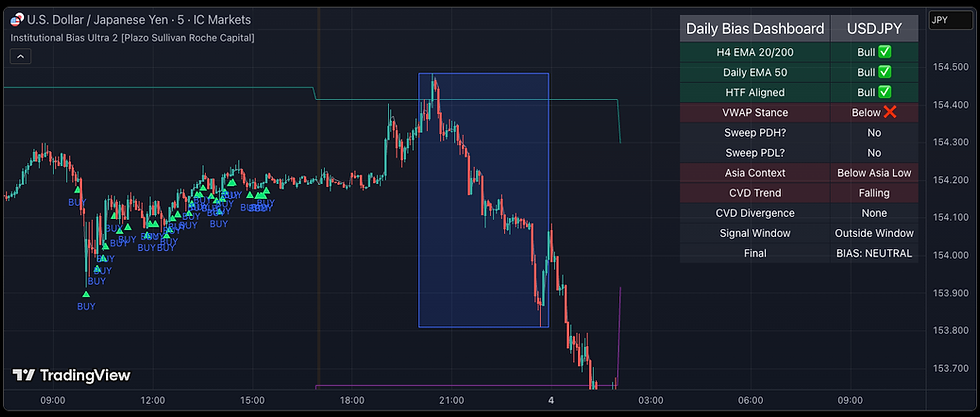The Crypto Reaper Indicator
- Sandra Wakefield

- 11 hours ago
- 4 min read

(Core logic, protections, and how to run it like a pro — concise edition)
Download Free: https://www.tradingview.com/script/lOduoxCx-Crypto-Reaper-Pro-Plazo-Sullivan-Roche-Capital/
To acquire the fully automatic cbot version, email us.
1) What it does
Prints BUY/SELL signals only when higher-timeframe bias, session window, structure confluence (FVG/OB + sweep), and CVD proxy divergence align, then overlays SL/TP targets (keeps only the last two sets) and shows a compact HUD.
2) Presets & Inputs (how to get realistic defaults fast)
Preset & Auto-apply
Preset: Crypto, Forex, Metals, Indices
Apply Preset Automatically: sets sensible defaults for session hours, CVD smoothing, FVG lookback, ATR buffer, and TP/SL multiples per asset class.
HTF Filters
Enable HTF Bias Filter → uses H4 SMA (200 or 20) and Daily SMA (50 by default).
Long bias: price > H4 SMA and price > Daily SMA
Short bias: price < both
Disable to allow counter-trend entries (not recommended intraday).
Session / Execution Window
Limit Signals to Session, Timezone, Session (HHMM-HHMM), Days.
Presets:
Crypto: 24/7 (filters off)
Forex: 08:00–17:00 London (Mon–Fri)
Metals: 08:00–17:00 New York (Mon–Fri)
Indices: 09:30–16:00 New York (Mon–Fri)
Structure & Confluence
Require Recent FVG/OB: needs a recent 3-bar FVG zone or a simple OB approximation.
Require Liquidity Sweep: needs a wick through the most recent swing high/low (pivot-based) and close back inside.
Displacement ATR Multiplier: minimum body size vs ATR to qualify an OB.
CVD Proxy Divergence
Require CVD Divergence: bullish = price makes lower low while CVD makes higher low; bearish = price higher high while CVD lower high.
CVD Smoothing: SMA on cumulative (volume × candle direction).
Signals / HUD
Toggle plotting and HUD; choose corner.
SL/TP Overlay
Stop Method: OB+ATR (contextual) or ATR only (mechanical).
ATR Buffer for SL (e.g., 0.5 ATR), TP1 (R), TP2 (R) (e.g., 1.5R / 3R).
3) Entry logic (what must be true to fire a signal)
Shared gatekeepers
HTF Bias matches direction (unless filter disabled).
In Session (unless session filter disabled).
Structure OK:
If Require Recent FVG/OB is ON → must be inside a recent Bull FVG or Bull OB (for longs) / Bear FVG or Bear OB (for shorts).
Liquidity Sweep (if ON):
Long: sweep prior swing low and close above it.
Short: sweep prior swing high and close below it.
CVD Divergence (if ON): pivot-based bullish/bearish divergence.
Trigger Candle: Engulfing pattern in the trade direction.
Bar Confirmation: signals only on confirmed bars (barstate.isconfirmed) to avoid intra-bar flicker.
Final conditions
Long: Bias Long ∧ In-session ∧ (FVG/OB ok) ∧ (Sweep ok) ∧ (Bullish CVD div) ∧ Bullish engulfing.
Short: Bias Short ∧ In-session ∧ (FVG/OB ok) ∧ (Sweep ok) ∧ (Bearish CVD div) ∧ Bearish engulfing.
4) Risk model (overlayed automatically)
On each signal (confirmed bar):
Entry at close.
Stop-Loss (SL)
OB+ATR: uses nearest OB boundary (or last pivot) ± ATR buffer.
ATR only: entry ± ATR buffer.
Targets: TP1 = R × risk, TP2 = R × risk (R from entry–SL distance).
Chart hygiene: script keeps only the last two SL/TP sets (and trims labels) to stay uncluttered.
Tip: For noisier assets (alts), use larger ATR buffer and slightly lower TP1 (e.g., 1.3R). For indices/metals, keep buffers tighter but respect session filter.
5) Protections (why false signals are filtered)
HTF Bias Filter: avoids fighting the prevailing 4H/D trend.
Session Filter: restricts to liquid hours; reduces chop/slippage.
Structure Confluence: requires recent FVG or OB context → trades are taken at value zones, not in the middle of nowhere.
Liquidity Sweep: demands a stop-run then reclaim — a high-quality reversal/continuation tell.
CVD Proxy Divergence: volume-direction proxy must disagree with price extremes → filters late/chasing entries.
Engulfing Trigger: ensures decisive intent from participants.
Bar Confirmation: no intra-bar repaint of signals; pivots confirm by definition.
6) HUD & Alerts
HUD shows: Preset, HTF Bias, Session status, FVG/OB status, Sweep status, CVD divergence state, SL/TP R-multiples, and Session TZ.
Unified Alerts:
CRP: BUY / CRP: SELL with ticker, timeframe, and close price.
Use these for webhook/automation or notifications.
7) Tuning guidelines (per asset class)
Crypto
Often 24/7: leave session filter OFF (default).
Volatile pairs → CVD Smooth 5–9, ATR Buffer 0.5–0.8, TP1 1.3–1.8R, TP2 2.5–3.5R.
Forex (majors)
Focus London/NY windows; keep session ON.
CVD Smooth 7–11, ATR Buffer 0.4–0.6, TP1 1.2–1.6R, TP2 2.0–2.8R.
Metals (XAU/XAG)
NY day is king; session ON.
CVD Smooth 7–9, ATR Buffer 0.7–0.9, TP1 1.5R, TP2 3R.
US Indices
Cash session ON (09:30–16:00 NY).
CVD Smooth 7–9, ATR Buffer 0.8–1.0, TP1 1.5R, TP2 3R.
8) Best-practice playbook
Top-down: confirm HTF structure; leave the HTF filter ON unless specifically testing counter-trend scalps.
Trade at edges: prefer signals that touch/enter FVG/OB boundaries.
Respect the sweep: if sweep didn’t happen, skip marginal setups (it’s a high-value filter).
Adapt ATR buffer: widen during news/volatility; tighten in calm regimes.
Scale-out optionality: many pros take partials at TP1 and trail or hold runner to TP2 (manage this externally; script plots levels).
Test by market: presets are starting points — forward test each symbol/timeframe before going live.
9) Repainting & data caveats
Signals: printed only on confirmed bars, so they do not repaint.
Pivots: by design confirm after phRight bars; once confirmed, they’re fixed.
CVD Proxy: uses cumulative (volume × direction) with SMA; venue/volume quality varies across symbols/exchanges.
Sessions: ensure your chart’s exchange vs. session timezone is correctly set to match expectations.
10) Troubleshooting (fast)
No signals?
You’re probably over-filtered. Temporarily turn OFF CVD or Sweep to isolate. Confirm in-session and HTF bias.
Too many signals?
Turn ON FVG/OB and Sweep; raise displacement ATR multiplier; increase CVD smoothing.
Levels look too tight/loose?
Adjust ATR buffer and/or switch Stop Method.
11) Safe-use reminder
This is an analysis tool, not financial advice. Always forward-test, size conservatively, and use hard stops.



Comments